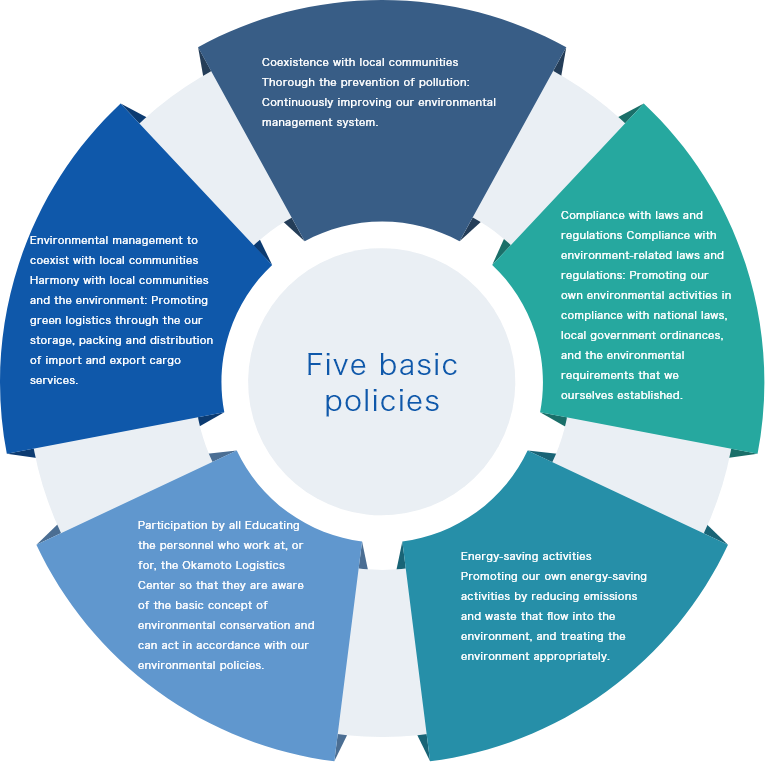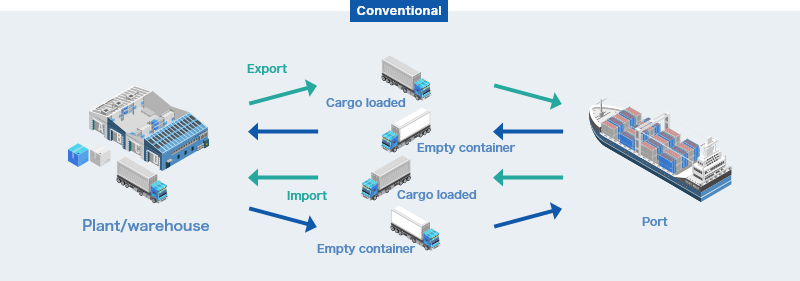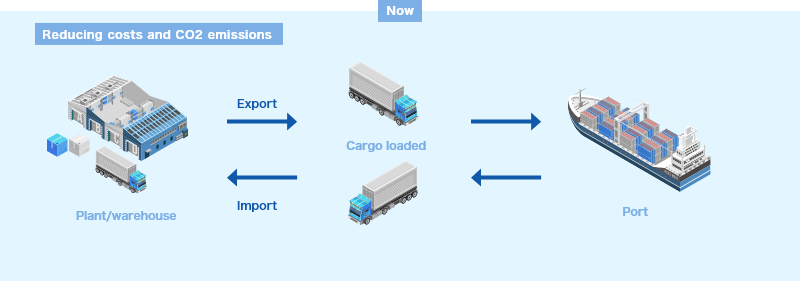Environmental initiatives and CSR
In the logistics industry, we will do what we can for local communities and the natural environment. We are striving to reduce CO2 emissions and conserve lumber resources by promoting environmentally friendly green logistics.
As a logistics trading company, we aim to improve operational efficiency and cost reduction, while fostering the enrichment of humanity, while implementing measures for the environment by voluntarily addressing environmental issues, including thinking of what we can do for the local communities and the natural environment.
Basic Principles and Policies ISO14001
initially registered on August 9, 2002
Okamoto Logistics Center
Basic principles
Each and every one of us will pursue the enrichment of humanity by voluntarily and continuously tackling environmental issues, and through harmony with the natural environment and coexistence with local communities.
Basic environmental policies of Okamoto Logistics Center
1. Harmony with local communities and the environment
Through our storage, packing and distribution of import and export cargo services, we will promote green logistics and always be always aware of the environmental impact of our business operations, allowing us to perform environmental management in harmony with the local communities.
2. Thorough prevention of pollution
We will continuously improve our environmental management system to reduce the environmental impact and to create a recycling-oriented society.
3. Compliance with laws and regulations concerning the environment
We will promote our own environmental activities in compliance with national laws, local government ordinances, and the environmental requirements we ourselves have established. We will try to make no errors and receive no complaints.
4. Appropriate use of resources without producing meaningless waste
We will promote our own energy-saving activities by considering the reduction of environmental impact from our business operations, reducing emissions and waste that flow into the environment, and treat the environment appropriately.
5. From a view of participation by all
We will educate all personnel who work at, or for, the Okamoto Logistics Center, so that they are aware of the basic concept of environmental conservation and can act in accordance with our environmental policies.

Past activity results
FY 2018: Goal achievement (renewed every year, Yokohama Office)
FY 2018: Objectives and goals (renewed every year, Yokohama Office) Result of green logistics and round use
Okamoto Logistics has succeeded in significantly reducing costs and CO2 by implementing round use, by which we do not return imported containers after shipment to container yards but use them inland for the next export cargo.
We will try to expand the use of containers for other cargo in order to promote the reduction of CO2 emissions.
FY 2016: Goal achievement
| Objective | Reducing power consumption | Recycling industrial waste and maintaining valuables | Reducing CO2 emissions by promotion of green logistics and round use of import containers |
|---|---|---|---|
| Desired value | 241,539 kWh/year | 19,249 kg/year | 3,330 containers/year Reducing 73,684 t-CO2/year |
| Achieved value | 234,269 kWh/year * Increase by 3%: Almost flat | 100%/year 100% | 3,751 containers/year 119% Reducing 131,946 t-CO2/year |
| Evaluation | 〇 | 〇 | 〇 |
FY2017: Objectives and goals
| Environmental policies | ○ | ○ | ○ |
|---|---|---|---|
| Legal and other requirements | ○ | ○ | ○ |
| Significant environmental aspects / Beneficial environmental aspects | ○ | ○ | ○ |
| Technical options | ○ | ○ | ○ |
| Requirements regarding finance, operation, and business activities | ○ | ○ | ○ |
| Opinions of stakeholders | − | − | ○ |
| Objective | Reducing CO2 emissions by reducing power consumption | Reducing CO2 emissions by reducing use of LPG fuel for forklifts | Reducing CO2 emissions by promotion of green logistics and round use of import containers |
| Reference value | 234,269 kWh/year Emitting 119,477 t-CO2/year | 16,609 kg/year Emitting 49,827 t-CO2/year | 3,751 containers/year Reducing 131,946 t-CO2/year |
| Desired value | 229,584 kWh/year Emitting 117,088 t-CO2/year Reducing 2,890 t-CO2/year | 16,111 kg/year Emitting 48,333 t-Cos/year Reducing 1,495 t-CO2 | 4,500 containers/year Reducing 158,335 t-CO2/year Reducing 26,389 t-CO2 |
| Goal | When compared with FY2016: Reduction of 2% (1) Dividing work areas from storage areas. (2) Taking measures for power saving in summer and winter. (3) Reducing working hours by improving workability. (4) Detailed power management by utilizing equipment visually indicating power consumption. |
When compared with FY2016: Reduction of 3% (1) Improving forklift work efficiency. (2) Improving forklift working lines. (3) Carrying out eco driving. (4) Introducing energy-saving forklifts. |
When compared with FY2016: Carrying out round use of 4,500 containers. Increase of 20% (number of containers) (1) Further expanding round use by aggregating the Koga Plant of Hino. (2) Utilizing the inland container depos (ICDs) around Koga. (3) Enhancing diversion of other shipping companies’ containers. (4) Strengthening cooperation with other shipping companies. |
Carrying out round use
Okamoto Logistics has succeeded in significantly reducing costs and CO2 by realizing round use, in which imported containers are not returned to the CY yards after cargo shipments but are diverted inland to the next export cargo.
We will make efforts to reduce Co2 emissions by expanding diversion.


Active use of returnable racks and development of boltless racks
Okamoto Logistics has succeeded in significantly reducing costs and CO2 emissions by realizing round use, in which the imported containers are not returned to the CY yards after cargo shipments but are diverted inland to the next export cargo.
We will make efforts to reduce CO2 emissions by expanding diversion.
